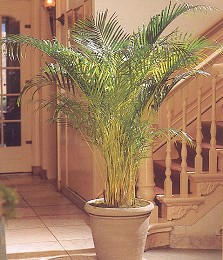Victorian and Edwardian
The cool, dark rooms of the Victorian era ideally suited ferns, to the extent that there were fashion crazes for planting ferneries at the time. Typically the Edwardian era is best summed by the aspidistra, a sturdy and long-lived plant with long, dark leaves. Rex begonias, too, with their deep metallic colouring, tone well with the dark plums, bronzes and greens of furnishings of the time.
Using plants to achieve the look
Think in tones – The most frequently used shades of the time were grey, pea green, sea green, olive green and fawn. Go for an internal décor, then, that makes the most of plants with plenty of greenery.
Room for everything – The typical middle-class drawing room was crammed full of furniture, fabrics were used in abundance and every available surface was overflowing with ornaments and nick-nacks.
Sweet harmony – Echo your choice of wallpaper with flowers that bring the Victorian or Edwardian garden inside. Try loosely arranged bunches of sweet peas, roses and lilac. House palms are also typically Edwardian.
Fern Britain – The Victorians’ were obsessed with ferns, an interest prompted by a greater knowledge of the wider world and the growth in the science of plants and flowers among amateur botanists.
Plants and flowers to consider
- Lemon Button Fern – The dainty Lemon Button fern produces cute, golden-green fronds with rounded edges that give it the button-like appearance. It’s an easy-to-grow fern that fits in well with a lot of decorating styles.
- Sweet Pea – “Here are sweet peas, on tip-toe for a flight, With wings of gentle flush o’er delicate white, And taper fingers catching at all things To bind them all about with tiny rings.” This is Keats on the subtle beauty of the highly scented Sweet Pea, much favoured by the Victorians.
- Pygmy Date Palm – Also called the Dwarf Date Palm, this Canary Island native will only reach 3-4 ft high but it’s among the most popular of indoor palms because its long, feathery fronds will eventually sprawl just about as wide as it is tall, providing truly dramatic accents to a room.
- Roses – No Victorian or Edwardian drawing room would have been complete without a display of freshly cut roses. Think pretty pinks, gentle yellows, pastel peaches, crisp whites and, of course, classic English reds.
- Violet – The Victorians were very knowledgeable in flower language and chose carefully. Flowers gave them a secret language that enabled them to communicate feelings that the strict society rules of the times would not allow. Violets conveyed faithfulness and modesty and were popular for their sweet scent.
Tips
Ornate brass planters, decorated glazed ceramic pots and cut-glass vases best suit the mood of these interiors.
References
http://www.bbc.co.uk/homes/design/period_edwardian.shtml
http://www.victorianstation.com/inter.htm
http://victoriandecorating.blogspot.com/2007/02/victorian-decorating-1830-50.html
http://www.bhg.com/gardening/houseplants/ferns/9-top-ferns-to-grow-as-houseplants/
http://www.sweetpeas.org.uk/
http://www.guide-to-houseplants.com/indoor-palm-trees.html
http://apps.rhs.org.uk/advicesearch/profile.aspx?PID=153
http://www.gardenersnet.com/lilac.htm
http://www.victorianbazaar.com/meanings.html



